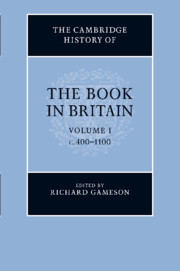Book contents
- Frontmatter
- 1 From Vindolanda to Domesday: the book in Britain from the Romans to the Normans
- PART I THE MAKING OF BOOKS
- PART II THE CIRCULATION OF BOOKS
- PART III TYPES OF BOOKS AND THEIR USES
- 15 The book in Roman Britain
- 16 The use of the book in Wales, c. 400–1100
- 17 The biblical manuscripts of Anglo-Saxon England
- 18 Anglo-Saxon gospel-books, c. 900–1066
- 19 Liturgical books
- 20 Anglo-Saxon prayerbooks
- 21 Psalters
- 22 Music books
- 23 Anglo-Saxon schoolbooks
- 24 Law books
- 25 Manuscripts of the Anglo-Saxon Chronicle
- 26 Old English homiliaries and poetic manuscripts
- PART IV COLLECTIONS OF BOOKS
- PART V CODA
- Bibliography
- Concordance of named manuscripts
- Index of manuscripts
- General Index
- Plate 4.1: The Lindisfarne Gospels"
- Plate 5.1: The Lichfield/St Chad Gospels"
23 - Anglo-Saxon schoolbooks
from PART III - TYPES OF BOOKS AND THEIR USES
Published online by Cambridge University Press: 28 March 2012
- Frontmatter
- 1 From Vindolanda to Domesday: the book in Britain from the Romans to the Normans
- PART I THE MAKING OF BOOKS
- PART II THE CIRCULATION OF BOOKS
- PART III TYPES OF BOOKS AND THEIR USES
- 15 The book in Roman Britain
- 16 The use of the book in Wales, c. 400–1100
- 17 The biblical manuscripts of Anglo-Saxon England
- 18 Anglo-Saxon gospel-books, c. 900–1066
- 19 Liturgical books
- 20 Anglo-Saxon prayerbooks
- 21 Psalters
- 22 Music books
- 23 Anglo-Saxon schoolbooks
- 24 Law books
- 25 Manuscripts of the Anglo-Saxon Chronicle
- 26 Old English homiliaries and poetic manuscripts
- PART IV COLLECTIONS OF BOOKS
- PART V CODA
- Bibliography
- Concordance of named manuscripts
- Index of manuscripts
- General Index
- Plate 4.1: The Lindisfarne Gospels"
- Plate 5.1: The Lichfield/St Chad Gospels"
Summary
Pedagogy
Anglo-Saxon schoolbooks might be defined as the books read, taught or potentially available in an Anglo-Saxon monastic or cathedral school. Yet immediate – and in many cases unresolvable – objections arise from this position. One might say, in fact, that the evidence can embrace contrary hypotheses: either the Anglo-Saxons had rigorous book-centred schooling that progressed from grammatical instruction to advanced reading, or they had just enough education to manage ecclesiastical duties, meditative, liturgical or administrative. Most argue a position of brilliance and ubiquity. But the truth is, our account of Anglo-Saxon pedagogy derives from late Roman and provincial precedents (of Gaul, mainly), extant booklists or books (native and otherwise, annotated or not, Latin and vernacular), and descriptions of monastic routines, both English and Continental. None of this evidence can be appraised without equivocation, especially because the existence of books never guarantees their use in a classroom.
However defined, the schoolbooks were nearly always written in Latin, an acquired language indispensable to the transmission of Christian culture. Determining whether and how a book was taught in the pre-Conquest period therefore means assessing bilingual competence. An Anglo-Saxon had almost no native linguistic cognates, let alone a comparable syntax (apart from inflections), for decoding Latin, which second-language practitioners of diverse ability taught to learners also of diverse ability. Furthermore, we must acknowledge passive and active competencies, reading versus writing, with the presumption that the proficiency of a brilliant native author may not reflect that of any native reader.
Keywords
- Type
- Chapter
- Information
- The Cambridge History of the Book in Britain , pp. 507 - 524Publisher: Cambridge University PressPrint publication year: 2011
- 1
- Cited by

